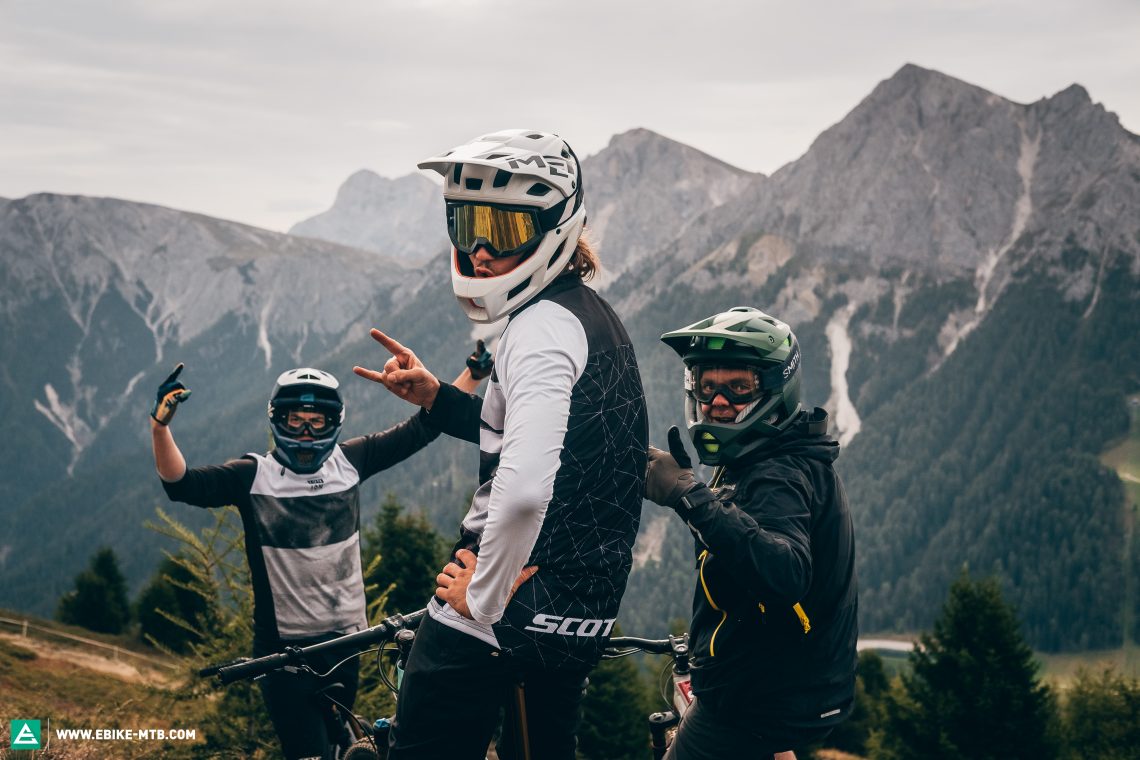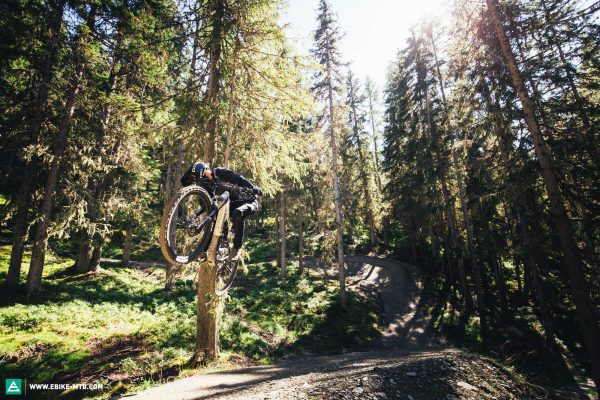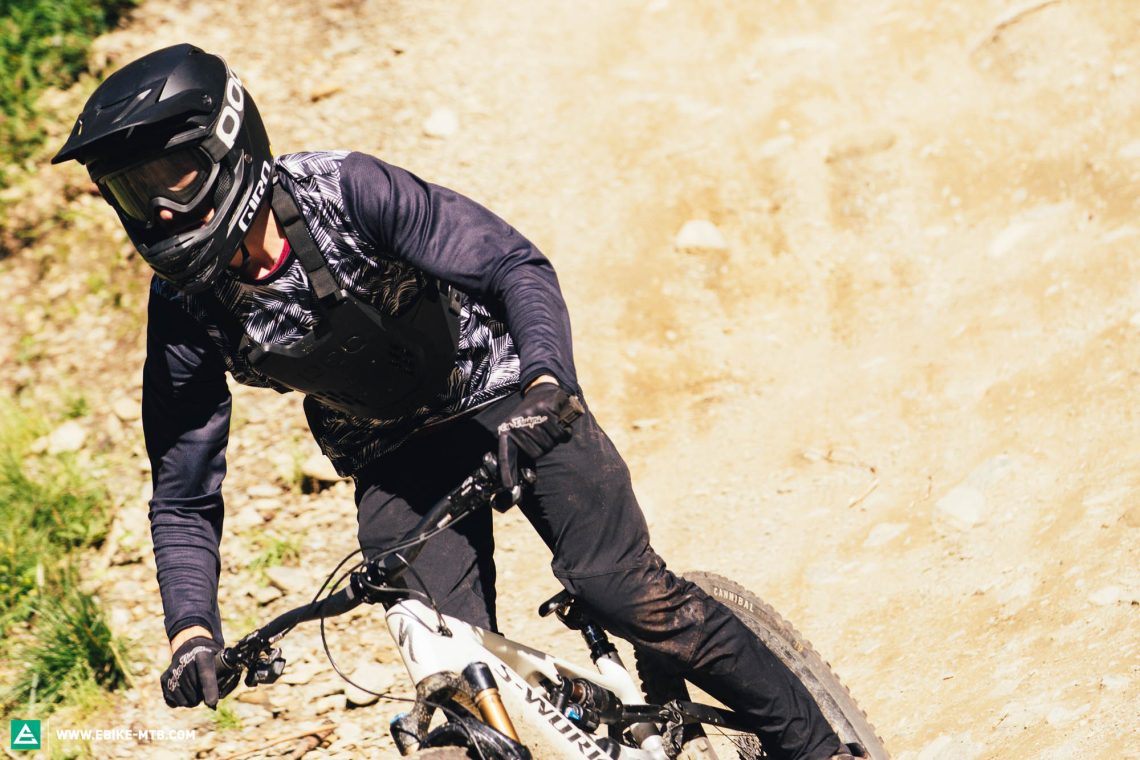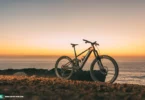Not only does a bike park session boost your confidence and skills but also helps you understand what you and your eMTB are capable of! Riding electric can be a great way to revisit familiar bike park routes and push yourself beyond them! In this guide we’ll tell you everything you need to know about your next electrified bike park session!
Here you can find all the information you need to prepare for the e-bike day in the bike park:
- Bikepark ≠ Bikepark
- Bikepark vibes
- Time machine: why you should ride more park with your eMTB
- Bikepark with an eMTB – new possibilities and more freedom
- The right eMTB and equipment for bike park riding
- The right mindset for bike park riding
- eMTB uplifts done right!
- Good vibes only – consideration and respect while eMTBing
- Maintenance and service

Imagine yourself gliding through the air, weightlessly floating through a wormhole with a rugged moon-like mountain landscape as a backdrop. Everything seems to happen in slow motion and you’re really enjoying the moment. As you’re approaching the landing, the ground slowly materialises under your feet, making you feel as if you were born again. No, you aren’t on the set of yet another “Back to the future” sequel, and yet you feel like a time traveller. But what does this have to do with a day at the bike park? Read on to find out!


Bikepark ≠ Bikepark
Bike parks are like a supermarket’s snack aisle: very tempting! Luckily, they increase your skills instead of your body weight. Everyone knows that chocolate and gummy bears are both sweets, even though they have pretty much nothing in common. The same goes for bike parks. So before we talk about which bike is the right bike park bike for you, we have to clarify our definition of a bike park and our expectations of it. The selection of routes, topography and shuttle options couldn’t be more different and will play a role in determining the type of rider it is suited to. Thank goodness we’re seeing more and more bike parks emerge with a very wide range of trails for every type of rider. On the one hand, you’ve got the flow lines in Sölden, on the other, the insanely steep downhill route in Champery, and in the middle, you’ve got incredibly multi-faceted parks like Whistler, probably the largest bike park in the world. Depending on where you are, there will be creaky t-bar lifts, modern chair lifts, pickups with trailers or brand new gondolas with special bike racks. Again, depending on the bike park, you’ll find every conceivable type of downhill track, from easy and flowy to “WOAAAAAHHH – never in a million years!”. As such, it’s extremely important to know what your limits are, what you want to learn to ride, what the respective park has to offer and to what extent you can progress at that park. You can have the time of your life on supposedly easy trails and even experts can continue to improve their skills on them, learning to ride more cleanly or try out new techniques.

1 day at the bike park corresponds to 10 days of home trails or 30 days of tours
At the trailhead, there’s usually a sign with all key features of the trail, including the difficulty rating and type of terrain, which is meant to help you understand whether or not a trail is suited to your skills and riding style. Depending on the size of the bike park, you’ll also find a number of services such as a bike rental station, workshops and washing stations.


Bikepark vibes
If you’re planning on spending several days with your family and friends at a bike park within a ski resort that opens its doors to bikers in summer, you’ll be able to check into a spa hotel nearby and relax after an eventful day on the trails. This way, a simple bike park trip becomes a mini family holiday with a touch of all-inclusive Dolce Vita goodness. Here the hotels are usually in the immediate proximity of the bike park and offer their guests a wide range of services including a car park, secure bike storage and sometimes even a washing station for the bikes. Do you get claustrophobic in hotel rooms and prefer to camp out in a tent or even have a van or car with a roof tent? That’s an excellent option too, because in many bike parks you’ll find a designated camping area right next to the valley station of the lift. While on a campsite you have to rough it a little and renounce the amenities of a luxury hotel, they’ll get you a real taste of bike park life and paddock vibes, allowing you to make new friends while saving tons of cash.


Time machine: why you should ride more bike park with your eMTB.
Riding bike park is a bit like boarding a time machine. The only difference is that you’re travelling onboard an eMTB and not a pimped-out DMC DeLorean with a flux capacitor. Whatever bike you use, a day at the bike park corresponds to roughly 10 days of home trails and 30 days of touring. Simply put, a bike park session is the best and quickest way to take your riding skills to the next level. Regardless of whether you’re a newbie or a pro, a touring enthusiast or a tireless trail bum, no other place allows you to pile up as many laps in such a short time, certainly not on the same trail (a great way to practise key sections over and over) and with such a huge variety of trails. Moreover, you really get a chance to make your rotors glow, because bike parks tend to have very long descents – far longer than your average home trail unless you live in the Himalayas. That’s exactly how most of the pros have started off their careers, learning the ropes on their home trails and refining their skills at the bike park. These are scattered with jumps and berms for all skill levels, thus allowing beginners to progressively build up confidence and skills. Pro riders, on the other hand, can play with the countless trail features and explore their limits on “easier” routes. While at the end of a bike park session you’re still the same age as at the beginning of the day, your bike skills could have improved by a few dozen light years in just a few hours.


Bikeparks and eMTBs – new possibilities and more freedom
At this point, the eMTB has to surrender to the time machine – embarking on a journey into the next millennium might be pushing it after all! And yet, eBikes still have a massive touring potential, allowing you to embark on epic backcountry expeditions you wouldn’t even dream of without motor assistance. For example, scouting for trails in the fleeting light of dusk when everyone’s still fast asleep sounds like a great plan all of a sudden! Jump on your bike, ride past the stationary lift and steam up the mountain straight to the trailhead, where you’ll be the first soul on the mountain to drop into the valley with the golden morning sun on your face. But beware: for your own safety, always try to ride at least with one more person – riding in a group is a lot more fun anyway. When the bike park opens and big crowds of riders rush to the lift, it’s fairly normal for queues to form, especially on busy weekends and bank holidays. With your eMTB, you can avoid the queue and ride straight to the top of the mountain, sometimes even getting to the trailhead before your mates with the gondola. On the way up, you can stick to a normal fire road or free your flow on a techy path in the woods. Flowing trails wind their way up the mountain through the forest, ensuring tons of fun, even uphill. You can ask the locals to share some cool insider tips and secret trails with you and if you’re lucky, you’ll experience the bike park from a totally different perspective – something you wouldn’t be able to do with an analogue mountain bike!



The right eMTB and equipment for bike park riding
To ride bike park you need the right bike and some eMTBs aren’t suitable for this purpose, regardless of your skills! So, which type of ebikes are suited for bike parks and what factors should you take into consideration? When answering these questions it’s difficult to make a blanket statement, because the optimal choice of bike heavily depends on the trails and, above all, the rider. However, as a general rule of thumb, a suitable geometry and good suspension play just as crucial a role as a robust set of tires, a dropper post and reliable, powerful brakes. The Pole Voima, Mondraker Crafty R, Specialized Turbo Levo, Yeti 160E T1 and Rocky Mountain Altitude Powerplay C70, which we have already reviewed for you, all cut a fine figure at the bike park. For more bike suggestions, check the Riding Characteristics chart in our group tests and look for a bike that is suitable for fast and demanding terrain, which is what you’re going to find in most bike parks. According to your average post-ride pub babble, a heavy eMTB isn’t as much fun as a conventional mountain bike on the trail. But is this true? Fact is: the extra weight requires more physical effort but doesn’t necessarily make a bike less fun! Above all, you’ll notice the extra weight in your upper body, making demanding descents more strenuous. Nevertheless, adrenaline-laden jumping sessions are still an option with an ebike – after all you can fly through the air even with a heavy MX bike! When jumping, it’s crucial to carry enough speed and find the right timing. Wouldn’t it make more sense to remove the battery? Unfortunately, this isn’t always as straightforward as you might think, because the frame design of many ebikes doesn’t allow you to remove the battery or to ride without it. That being said, with some bikes you can remove the battery and use the lift to ride the conventional bike park trails. If you want to enjoy the perks of an eMTB to the full, avoiding endless lift queues and exploring new trails on your way to the trailhead while the world’s still fast asleep, just pop in the battery and knock yourself out! Without a battery, the bike is lighter and offers totally different riding characteristics, thus ensuring easier handling, less fatigue and as a result inspiring more confidence on the trail.

So, now that you know which bikes are best suited for bike parks, you should start preparing your eMTB for your next session. At the bike park, you’re piling up laps over laps in a short period of time, which inevitably puts a greater stress on your components. Before setting off, make sure the tires and brake pads are still in good shape and, while you’re at it, cover the most exposed and vulnerable frame areas with protective tape (or even an old inner tube) to prevent overzealous lift operators from damaging the frame. Handy tip: when visiting a bike park for the first time, always bring a fresh roll of protective film with you! Every lift is different and causes chafe marks in different spots on the frame. Before setting off for the first run, check the lift or shuttle truck to identify potential chafing dangers.


Is your time machine aka eMTB ready for the bike park? Excellent! Now you just have to sort out your riding kit and protective gear before hitting the trails! Before visiting a bike park, find out which protective gear you’re required to wear, because every bike park has different rules. In our eMTB protection guide, we’ll tell you which (and how much) protection you should wear when riding your eMTB. And yes, crashing is part of (e) mountain biking. Unfortunately, even the stupidest crash can sometimes lead to an emergency that requires you to help a riding buddy or a stranger – or them to help you! However, dangerous half-truths, long-forgotten first aid courses and even just plain ignorance will make things worse, which is why you should read our ultimate mountain biker’s guide to first aid.

Bike: check! Protectors: check! Now, wearing protective gear over your birthday suit isn’t a good look, so here are a few tips for your riding kit. First thing first, wear comfortable clothing. Although bike parks aren’t catwalks, we beg you to wear your protective gear under the jersey, unless you’re using a bulky back/torso protector like POC’s VPD System Torso or FOX’s Raceframe Impact. Moreover, schlepping a bulky backpack with all your belongings around the bike park is a bad idea and a back protector should be the only thing you wear on your back. Alternatively, you could use a hip pack, which ensures significantly more freedom of movement and still has huge storage capacity, or use a tool strap to attach a minitool and spare tube directly to the bike frame.

Finding the right mindset for a bike park session.
At some point, we’ve all approached a jump and thought to ourselves: “I’ll never make it!”. Most of the time, it’s just lack of confidence and we think that we aren’t capable of doing something because we don’t trust ourselves – three times out of four it’s because we’ve convinced ourselves that we can’t do it! Learn from other riders, ask them for advice and analyse their lines. Hang out with experienced riders, follow them at your own pace and within your own limits and you’ll notice huge improvements in a very short time . Needless to say, we’re not telling you to hit a five metre drop with no previous experience. Common sense, progression and a healthy serving of (self) respect are paramount when riding bikes: don’t cave in to peer pressure and opt for the chicken line if you’re not feeling it (chicken line = an alternative section to bypass a challenging trail feature)! If you want to delve deeper into the psychological aspect of riding bikes and need help finding the right mindset for your next bike park visit, you should read this article from our sister magazine ENDURO.

eMTB uplifts done right!
Enough with the theory, let’s hit the bike park! Most of the time, the lift is your quickest way to the trailhead. Alternatively, you can save money on the lift and pay a flat rate just to use the trails. In that case, you’ll have to get to the top of the mountain under your own steam or with the help of the motor. Small bike parks usually only have basic t-bar lifts, which most of us might know from ski resorts. However, increasingly more bike parks are upgrading their t-bar lifts with special stem adapters, making it easier for users to hop on and off the lift. Bigger bike parks usually rely on existing winter sports infrastructures, including modern chairlifts and state-of-the-art gondolas with special bike racks which allow you to transport your bike either inside or outside the cabin. Boarding a gondola or a chairlift without help can be nerve-wrecking at first, because you have to secure your bike to a moving chairlift before sitting down – and you have to do it quickly! But don’t worry, we’ve all been there and many chairlift stations have a dummy where you can practice the routine! When hanging the bike from the saddle, make sure your dropper is fully extended. If you still have problems, don’t stress, the lift staff’s there to help! On the way up, there isn’t much time to relax, so it’s crucial to use the time efficiently to refuel with a drink or a snack. While you’re at it, have a chat with your fellow gondola passengers, find out more about the trail conditions and ask them to join you for the next few laps. That’s the quickest way to make new riding buddies and find company for your next bike park trip.



Good vibes only – consideration and respect while eMTBing
Our sport should be exclusively about having fun! (E-)Mountain biking has long become a mass sport and is extremely popular, which means that there are lots of us out there. Although bike parks are a sort of amusement park for mountain bikers and hikers aren’t allowed on the trails, you should be just as considerate and tolerant as you would be on your home trails, because you’re sharing the space with other human beings – and a bike park isn’t a race track! Before dropping into a trail, remember that difficulty ratings aren’t standardised and differ from bike park to bike park: for example, an Austrian black track is a blue line in France. Take your time, get familiar with the trails and pay attention to the signage, because jumps and intersections are usually marked. If you’re unsure about a feature, take a moment to check it out – and if you do so, make sure you stop in a safe place and never on the trail!


Bike maintenance and servicing: getting your eMTB ready for the bike park
The end of a ride is the beginning of the next! Everyone likes to start an epic day on the trail with a clean and well-functioning bike. Because a well tended eMTB rides better, lasts longer and is far more fun to ride. Make it a habit to inspect your bike after a weekend at the bike park and, if possible, after each ride on your home trails. Most bike parks have a washing station where you can hose down your rig after a long day on the trails. This avoids stress and unnecessary material wear. Once the bike is clean, it’s important to lubricate the chain and store the batteries properly.

A bike park is an excellent place to improve your skills, make new friends and have a blast on the bike. Whether you’re a newbie or a seasoned trail veteran, eMTBs open up a whole new world of opportunities, allowing you to see a bike park from a different perspective. If you take time to prepare yourself and your equipment properly and behave respectfully towards other trail users, riding bike park can be a fun, relaxing and safe experience. If you follow a few basic rules, everyone will have a great time and enjoy the bike park to the max! So what are you waiting for? Get ready and let’s hit the bike park! Let the time travel begin!

Did you enjoy this article? If so, we would be stoked if you decide to support us with a monthly contribution. By becoming a supporter of E-MOUNTAINBIKE, you will help secure a sustainable future for high-quality cycling journalism. Click here to learn more.
Words: Mike Hunger Photos: Diverse









